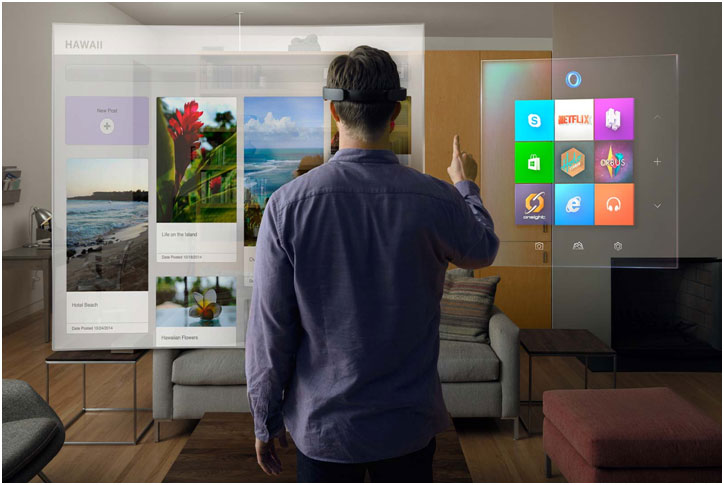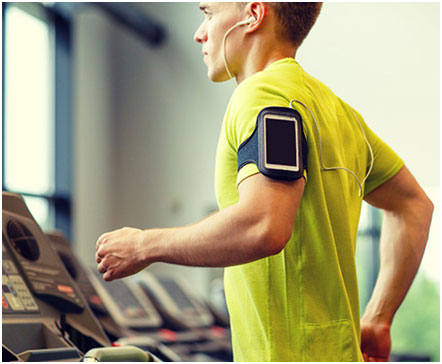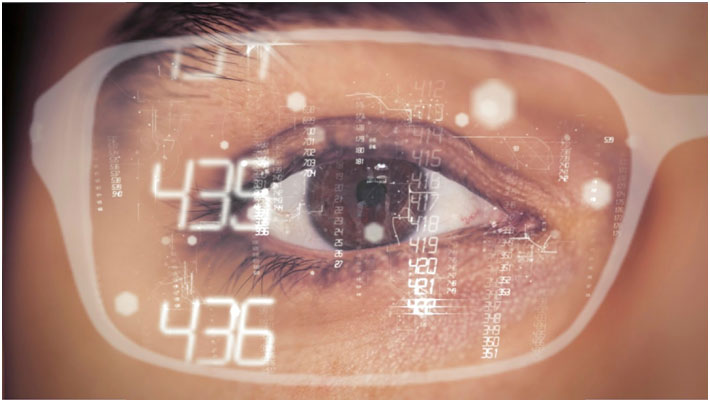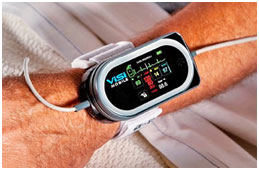Modern electronics gadgets have crossed the line of basic smart watches. Today’s wearable gadgets have incorporated smart or self-intelligence features in users hand along-with a fashion statement. This story is a collection of next-generation wearable gadgets being developed across the globe. Here we present some of them …
 Do wearable gadgets actually make us healthier?
Do wearable gadgets actually make us healthier?
Keeping track of your health has never been so easy, or so hip. Wearable gadgets are everywhere, it seems, helping people track their calorie intake, vital signs, sleep patterns and more, with little effort. Every minute of each day. But what does it all mean? With all the data captured, calculated and shared, are these health devices actually making us healthier? It depends on how you use them, and how you protect yourself in the process. Google Glasses and Apple Watches are just a few of today’s popular wearable gadgets, also known as “self-trackers” or “body hackers.” This highly sophisticated technology can help us monitor our personal habits as a means to self-improvement, a concept known as the “quantified self” movement. Wearable gadgets work by capturing the data of your choice, then sending your stats to cloud-based data systems. These systems analyze your numbers for patterns and offer feedback that can help you make decisions about your health. High blood pressure, chronic lung conditions like COPD, diet and exercise all can be managed with a wearable gadget. The health care industry has high expectations for the trend, hoping a more educated, empowered patient means fewer unnecessary doctor and hospital visits. For example, Smartphone glucose monitors can also help prevent diabetic shock by monitoring blood-sugar levels. Corporations like Walt Disney Co. are investing in the concept, too, using smart bracelets to track guest behaviors in a quest to improve the customer experience. It all adds up to big business. By 2016, wearable gadgets are expected to be a $5 billion market. When used appropriately, wearable gadgets can be educational, even beneficial. But it’s important to be aware of the inherent security and privacy risks. In a 2014 report, Symantec found that wearable gadgets were vulnerable to location tracking, which means hackers could find out sensitive information like your home address, running route and vacation habits. Many gadgets also exposed users’ passwords. But some concerns are anyway required to user away your gadgets like,
Keep your information safe: Use a screen lock or password on your device. Turn off your Bluetooth or Wi-Fi when not in use. Read your device’s privacy policy, and choose devices with encrypted security measures.
Be purposeful: Do you want to run faster? Control your blood sugar level? Sleep better? Map out a goal and measure your results.
Make it fun: Test yourself. Compete with your friends. Many health tracking devices have game mechanics that can help motivate and inspire you.
Keep it healthy: Whether you’re tracking all those numbers for fun or health, make sure the net effects are positive. If, for example, the constant monitoring has you stressed or frustrated, consider redefining your goals, or paring back how much you track.
How accurate are wearable’s?
 Unfortunately, precision of data displayed by wearables leaves much to be desired. It becomes obvious if we compare data shown by different devices for the same activity, or if we compare some smart trackers with regular pedometers. Smart bracelets are not precise enough because they’re affected by unintentional movements, excessive gestures or keeping an arm in the pocket. For your information, 0,25 miles are 540 steps for a regular pedometer and Jawbone UP!, 538 steps for FitBit One and 552 steps for Nike Fuelband.
Unfortunately, precision of data displayed by wearables leaves much to be desired. It becomes obvious if we compare data shown by different devices for the same activity, or if we compare some smart trackers with regular pedometers. Smart bracelets are not precise enough because they’re affected by unintentional movements, excessive gestures or keeping an arm in the pocket. For your information, 0,25 miles are 540 steps for a regular pedometer and Jawbone UP!, 538 steps for FitBit One and 552 steps for Nike Fuelband.
Tech bloggers and journalists have recently conducted a lot of experiments in order to detect and explain gaps and mismatch in data analysis by various gadgets. Shyam Patel had been testing Fitbit One, Jawbone UP, Nike FuelBand, and the BodyMedia LINK in the gym and real life for 28 days and had published a comparative review of data accuracy in his blog. One of his conclusions is that Fitbit usually “flatters” its users and somewhat exceeds the results, while, on the contrary, Nike FuelBand underestimates the results: 191,000 vs 116,000 steps. On average, deviation in results makes no more than 20% across all wearable bracelets compared. As such, app developers will be challenged to design and deliver higher precision applications for wearable activity trackers and monitors during 2014, as data accuracy will probably be one of the key factors impacting user purchasing decisions this year. And that’s where new developments in Big Data science will come just in time!
Some of the next gadgets ready to hit market are:
Smart-watches or Wrist Computers
Smart watches combine the traditional time keeping role of a watch with the role of a computer/ smart-phone that is more efficient in use. Depending on the make, the gadget will either work independently or in connection with a smart-phone. Travelers can download and install travel apps such as TripIt and booking platforms such as Jovago.com which enables consolidation of their flight plans, itinerary, directions and related mail updates to the wrist screen. This eases the travel experience, as you can view all push notifications without necessarily whipping a smart-phone or looking for your computer. Apart from the new convenience in mobility, advanced models such as Apple Watch have pulse rate monitors that can detect distress and anxiety. Maybe an innovation that will save us from unruly travelers, and late boarding!
Wrist Band Fitness Monitor
 The ‘strappy group’ of devices comes fitted with movement trackers, calorie-burning display units, and sleep monitors. This especially will work perfect for sport tourists e.g. trekkers and walkers, mountaineers and climbers as well as travelers taking a break for a swim or any other physical activity. Generally, wristbands will help one keep track and records of their activities which is vital in setting up lifestyle and meeting fitness goals. This will come in handy for travelers who may not be in contact with personal physicians or have no access to instructors. Water-resistant Smartphone Especially on outdoor activities. If you are going on a trail, scampering to find shelter for your wrist watch can be annoying- and so is un-strapping your watch every time you take a dive. A splash proofing smart-phone comes with the traveler-friendly advantage of being able to take your photos just anywhere! You can spend your sunset on Africa’s best beach destination without a worry, play pool volleyball all day long, take photos of hundreds of unique fish species while scuba diving and lay out to dry without worrying about your phone’s warrant!
The ‘strappy group’ of devices comes fitted with movement trackers, calorie-burning display units, and sleep monitors. This especially will work perfect for sport tourists e.g. trekkers and walkers, mountaineers and climbers as well as travelers taking a break for a swim or any other physical activity. Generally, wristbands will help one keep track and records of their activities which is vital in setting up lifestyle and meeting fitness goals. This will come in handy for travelers who may not be in contact with personal physicians or have no access to instructors. Water-resistant Smartphone Especially on outdoor activities. If you are going on a trail, scampering to find shelter for your wrist watch can be annoying- and so is un-strapping your watch every time you take a dive. A splash proofing smart-phone comes with the traveler-friendly advantage of being able to take your photos just anywhere! You can spend your sunset on Africa’s best beach destination without a worry, play pool volleyball all day long, take photos of hundreds of unique fish species while scuba diving and lay out to dry without worrying about your phone’s warrant!
Wearable Camera
Taking photos is every traveler’s pass time-now imagine taking photos endlessly. In this new era of baggies like selfie but taken immediately on arrival to hotel/destination for purposes of bragging to friends) The camera comes with an automated feature that enables it to detect the right moment for a photo, hence keeping a great record of your trip. For instance, if in Nairobi city center -your auto may take note of city monuments, traffic, or mobile traders, aspects that you may not consider with a traditional camera, yet very integral parts of the city daily living. The camera works through three sensors which pick up light intensity, speed of movement and temperatures in their “decision” for the best shot.
Noise Cancelling Headphones
From the drowning noises on takeoff to the tens of clicks from cameras in a zoo, unwanted noise is stressful. Getting a pair of good ANC headphones can make your journey more bearable. The headphones use microphones positioned on the ear cups for detection of any unwanted waves. Go for a comfortable lightweight in a compact pack -it should not form part of your hand luggage and Even with all the inventions, traditional etiquette remains. The greatest debate is whether we need or not need this technology; but as appears, technology is taking over travel. From the launch of robotic bartenders in world’s most geeky cruiser sheep-Quantum of the Seas- to simple gadgets such a selfie rod! We can only put our best savvy-geek forward and embrace a wearable decade ahead.
Lechal Shoes and Insoles
For instance, track steps and calories and sync with a smart-phone to provide haptic feedback for GPS navigation—convenient for activities like jogging or cycling, where looking down at your phone is a dangerous hassle. Also, this capability could be useful for people whose eyesight is impaired but want to be able to get around in their day-to-day lives.
The Automated Device for Asthma Monitoring and Management (ADAMM)
 ADAMM provides asthma sufferers with some extra control over a potentially life-threatening condition. Worn on the chest, this device tracks coughing, heart rate, and respiration while the wearer or caregiver supplements the data through an app. With constant monitoring, ADAMM can warn of an attack even before symptoms become obvious. Doctors can also use the data to better serve patients with a more complete picture of their particular situations.
ADAMM provides asthma sufferers with some extra control over a potentially life-threatening condition. Worn on the chest, this device tracks coughing, heart rate, and respiration while the wearer or caregiver supplements the data through an app. With constant monitoring, ADAMM can warn of an attack even before symptoms become obvious. Doctors can also use the data to better serve patients with a more complete picture of their particular situations.
Conclusion
No doubt wearable devices could turn out to be worth every one of the $53 billion dollars they’re expected to generate by 2019, but that will only happen if we cast them in the correct light. The problem with looking to wearable’s for the next evolutionary step in computing is that smart-phones and PCs are functionally identical. Wearable’s, on the other hand, are often dependent gadgets. Smart-phones were such a success because they took everything great about computers and put it in our pockets, no strings attached. A lot of wearables, such as smart-watches and digital eyewear, are next to useless when they’re not closely paired with the super devices we already carry. If, when smart-phones first came out, they were just tiny touch-screen monitors for our desktops that only worked within Bluetooth range—well, can you imagine needing that? Smart shoes, shirts, and even headphones all have something in common. Regardless of what they do, where on the body they sit, or how slick they were or weren’t designed, each of these devices should enhance our natural abilities.







